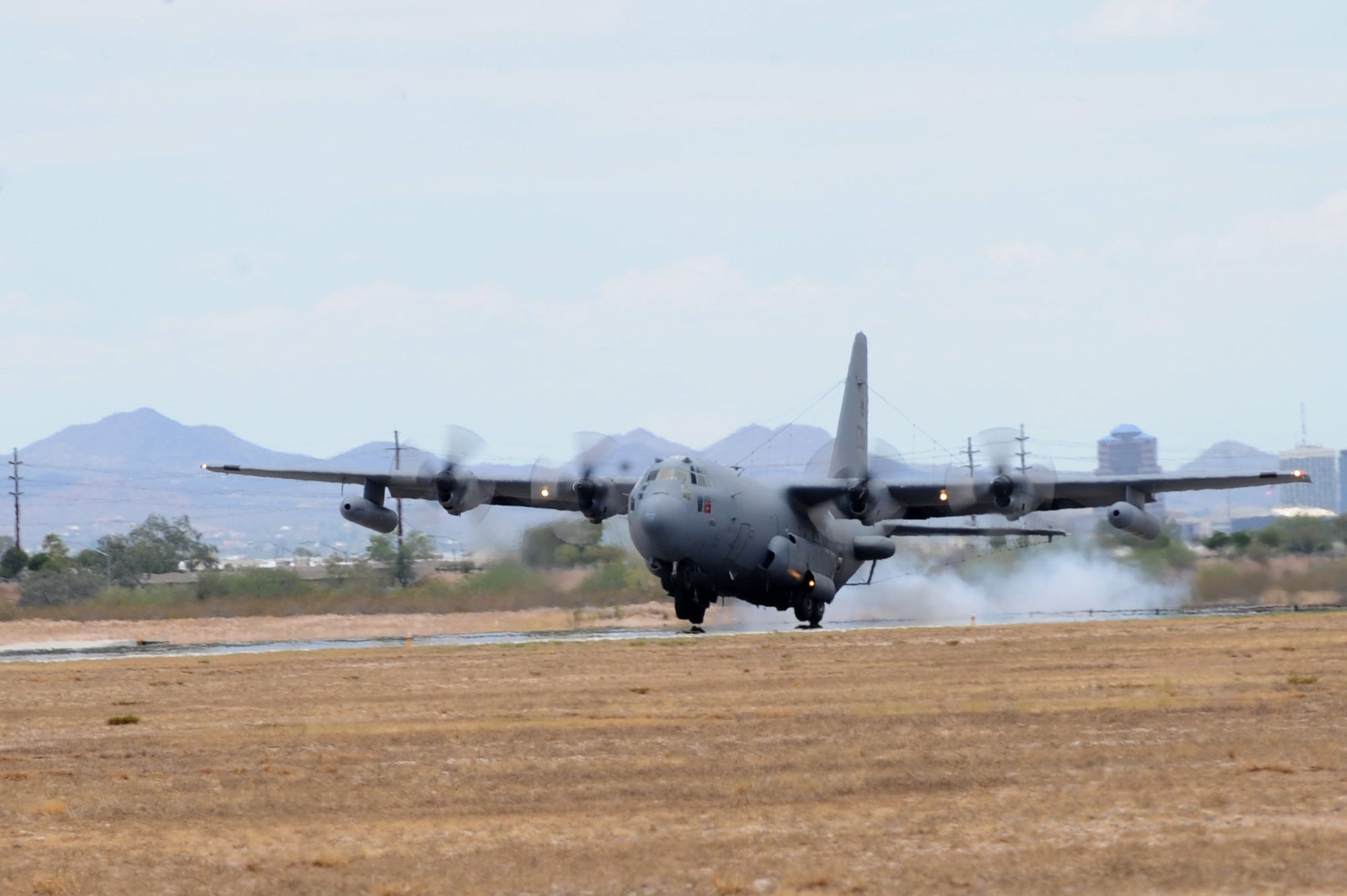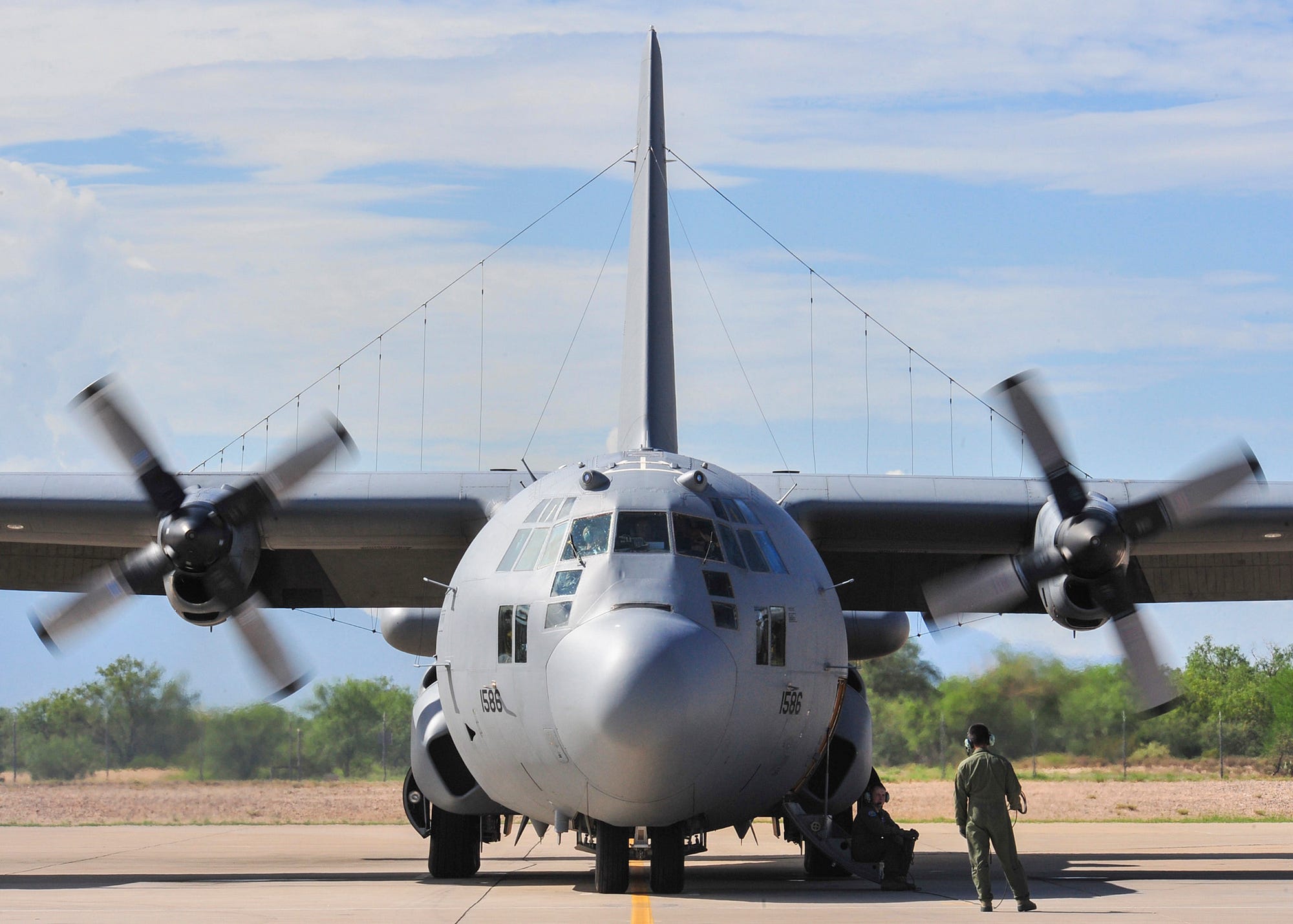JAMES DREW
The U.S. Air Force is winnowing down its fleet of EC-130H Compass Call electronic attack planes.
The 15 high-tech jammers belong to the 55th Electronic Combat Group at Davis-Monthan Air Force Base in Arizona. But if the flying branch has its way, it will retire seven at the turn of the fiscal year in October, according to the Pentagon’s latest budget request.
They’re few in number, but highly important planes. These are same EC-130Hs that twice shut down Saddam Hussein’s air defenses, and helped American pilots and troops return home alive from the conflicts in Kosovo, Haiti, Panama, Serbia and more recently Libya, Afghanistan, Iraq and Syria.
Compass Calls are heavily-modified C-130s that carry advanced jammers and counter-radar equipment to shut down just about any wavelength on the electromagnetic spectrum.
This allows U.S. warplanes to penetrate sophisticated air-defense systems and avoid detection by early warning radars. The EC-130H can even take down enemy command-and-control networks.
According to one former crew member, the Compass Calls can do things that the Navy’s Growler squadrons can’t, although the plane’s exact capabilities are classified.
Whether there’s a Compass Call available has sometimes been the deciding factor whether a special operations mission goes ahead, the ex-crew member said.
 Above—a Compass Call takes off from Davis-Monthan Air Force Base on July 10, 2014. At top—another EC-130H refuels above New Mexico on March 21, 2012. Air Force photos
Above—a Compass Call takes off from Davis-Monthan Air Force Base on July 10, 2014. At top—another EC-130H refuels above New Mexico on March 21, 2012. Air Force photos
Lynn Berg, a former EC-130H crew member and staff member at the Pentagon’s Joint Electronic Warfare Center, said eight airframes won’t be enough to fulfill requirements from the military’s combatant commanders.
“That should greatly concern the joint warfighting community,” Berg wrote in an email. “It’s widely acknowledged that military operations everywhere are growing increasingly reliant on electromagnetic energy for communications, sensing, satellite navigation, battlefield awareness and command and control.”
For the eight remaining aircraft, some will remain stateside for aircrew training, depot maintenance and modification.
Berg commended the Navy, Marine Corps and the Army for boosting their electronic warfare divisions. But he added that the Compass Calls are a lot more powerful than relatively newer jammers like the EA-18G Growler.
“Compass Call’s detailed capabilities are classified, but when you understand the complete list of what it can target across frequency range, geographic area, target type, and transmitter power, there is nothing comparable in the [Defense Department] inventory,” Berg wrote.
The Air Force appeared to agree in a carefully-worded report to the Senate Armed Services Committee last September. Even though the first EC-130H entered service in 1983, the service has regularly upgraded its electronic warfare systems.
The report came in response to concerns by the Senate about the fleet cut. The aircraft “has proven its value in every major combat operation since Operation Just Cause in 1989 through today’s conflict in Afghanistan,” the lawmakers wrote in its 2015 defense spending authorization.
According to the report, the Air Force estimates it would save approximately $300 million over four years by moving half of the Compass Call fleet to its aircraft boneyard in Arizona.
“The concerns of the Senate are appropriate,” the service wrote in the response, signed by Air Force Under Secretary Eric Fanning. “The decision to retire seven EC-130H aircraft was one not made lightly, but was driven by financial constraints and the needs of the Air Force to modernize in other areas.”
Those same budgetary concerns didn’t seem to apply for other missions, though. The Air Force requested $167 billion for fiscal year 2016—well above the sequester limit—to boost spending on new fighters, bombers, tankers, cyber forces, nuclear weapons, space launches, missiles, bombs and other programs.
The Air Force also pushed back retirement of the E-8 ground-surveillance planes, E-3 radar planes and U-2 spy planes due to “combatant commander requirements.”
Half of those fleets would have begun retiring from service in the 2016 fiscal year—if it wasn’t for pressure from Congress. The Air Force would have scrapped the U-2 entirely.
 A pre-flight inspection on an EC-130H Compass Call at Davis-Monthan Air Force Base in August 2014. Air Force photo
A pre-flight inspection on an EC-130H Compass Call at Davis-Monthan Air Force Base in August 2014. Air Force photo
The $300 million—or $75 million per year—in savings isn’t much, either.
Retiring half the Compass Call fleet would pay for less than a single Long-Range Strike Bomber—which will cost $550 million a piece once it enters production. One KC-46 tanker costs $180 million. One Global Hawk costs $95 million. One F-35 Joint Strike Fighter costs $88 million.
Those are conservative figures from the Pentagon’s 2013 selected acquisition reports, and do not account for development costs.
The Compass Call reduction would also come ahead of any plan to replace the aircraft with anything new. Air Combat Command has commissioned a series of studies to look at the service’s next airborne electronic attack aircraft.
The report indicated that the remaining EC-130s will receive upgrades through 2025. A report due in 2017 will explain what the follow-on jammer should be.
In an interview in December, the commander of the 55th Wing headquartered at Offutt Air Force Base, Nebraska, said there has been no action taken yet to retire any planes, but the wing is developing plans to comply with the force reduction.
“Now that we know we would have the same capability with our airframes, we just have to figure out what we’d do with less capacity,” Brig. Gen. Gregory Guillot said.
“So we’re working with Air Combat Command and the [Combatant Commands] to show we’d still have the same capability but just less of it, and ensure that we’re presenting forces in the right way if we do go down to eight.”
The general said the electronic combat group has a new Compass Call flight deck simulator, and two mission crew simulators at David-Monthan Air Force Base that should free up some airplanes that were previously kept back for training purposes.
“I think that will help us with a small force so more aircraft will be able to devote to the operational mission,” Guillot said.
John Knowles, editor of the Journal of Electronic Defense and a Compass Call advocate, said in 2013 that cutting the fleet was a game of “budget jeopardy” with Congress—when the Air Force first floated the idea.
Knowles wrote that Congress could block the retirement and approve extra cash to keep all 15 aircraft flying through 2016.
He added that the aircraft’s ability has grown beyond the original mission of jamming datalinks and integrated air-defense systems, to include disrupting radio-controlled improvised explosive devices, voice communications and long-range radars.
“The Air Force didn’t play this game with the F-22 fleet or the C-17 fleet,” Knowles wrote. “It targeted the EC-130H fleet, and that speaks volumes about how [Electronic Warfare] is perceived within the Pentagon.”
According to an Air Force fact sheet updated last November, Compass Call airplanes carry 13 airmen—two pilots, one navigator, one flight engineer, two electronic warfare officers, one mission crew supervisor, four cryptologic linguists, a target acquisition operator and an airborne maintenance technician.
Congressional defense committees will consider the budget proposal during the next few months, and Congress has to eventually approve it. If lawmakers want to keep the aircraft around, they’ll have until next January at the latest.
No comments:
Post a Comment